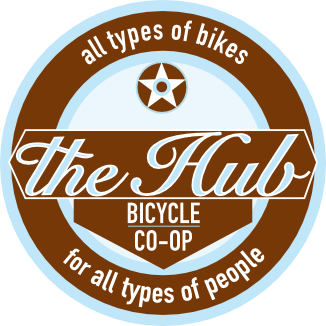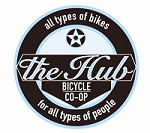
The Hub Bike Co-Op’s Quick Guide to
Winter Specific Maintenance and Riding:
There are many philosophies about the best combination of bike and gear for winter biking. Your best options will be different depending on what type of riding you plan on doing. Your terrain, length of ride, and your budget will be large influences on your choices. When starting out, do some research and get advice, then customize and experiment to find out what works for you. Lastly, have fun! Winter biking can be a great adventure.
Contents
for a downloadable PDF of this information, Click Here
also
Check out our Winter Riding Classes!
Clothing
Think Layers! Waterproof, windproof, and breathable outer layers are often the best, especially for your torso. Wool or synthetic under layers will help wick moisture and avoid cold, damp feelings. Usually you will have generated considerable body heat after 5-10 minutes so plan your clothing for a comfortable temperature after that time-frame or you will over heat on long rides (this usually means that you start out a little cold).
Layering Materials
- Wool is natural and effective. It wicks moisture, is durable, resists picking up odors, and thin layers can be used during the summer too. Wool requires special care, so read the tag! Some wools absorb water vapor before it condenses and so maintains a warm and dry microclimate around you.
- Synthetics offer good wicking, durability, and affordability. Moisture that doesn’t immediately pass through the fabric is not absorbed and can condense. It is then moved via capillary action away from your skin. This can give synthetics a damp feel at first when the water condenses, but they still wick exceedingly fast and effectively.
- Fleece is a good option because it entraps air (its good insulation). It can be wool or synthetic, but either way it wicks moisture, is one of the warmest options, and is usually light weight. Fleece can be too warm when used under a shell so it can be saved for the colder days.
Outer layers and Shells
- Waterproof, breathable shells are often cited as the best for all conditions. There are many laminates that offer similar performance to the well known Gore-Tex.
- Soft shells are gaining popularity because they can be more comfortable and release moisture better while still being windproof and highly water resistant. It is hard to find a fully waterproof softshell for less than $300, so don’t plan on using cheaper ones for your full-on rain jacket.
- In really cold conditions(well below freezing) waterproofness can be less important and windproofness becomes paramount.
Hands
Good wind resistant gloves or mittens are necessary for Minneapolis (with mittens, Bar Mitts, and heavy- duty lobster gloves being more important in the depths of winter). There are several gloves that are water and wind proof in full-finger, lobster, and mitten styles.
- Lobster claw gloves are the most versatile maintaining access to brake levers and shifters while still being warm by keeping your fingers paired up next to each other.
- Mittens are probably the warmest option but don’t work with all styles of handle bar setup. They tend to work well with fixies without handbrakes, time trial bars (or flip n’ clips), and some flat bar setups.
- Full-finger gloves are good for spring and fall riding before the weather hits rock bottom.
- Bicycle Handlebar Mittens (AKA BAR MITTS / Pogies / a.k.a. Moose Mitts) go on the handlebars and boost the warmth of any glove.
Feet
Keep footwear relatively loose, tight boots or too many sock layers can cut off circulation and cause numb toes. Wool socks with good loft are some of the warmest options.
- For those who demand year round clipless riding, there are several biking-specific winter riding shoes. Consider getting a size larger than normal so you have space for extra socks. Have a very good insole for clipless shoes as the the metal cleat conducts heat away from your feet.
- Wind-proof, insulated booties are also options, but they typically aren’t as warm as winter specific shoes. Some folks recommend using clipless sandles with neoprene booties and layers of socks (kind of a mukluk approach).
- Platform pedals (with or without toe clips/power grips) and heavy boots are a common option.
- In a pinch, a baggie wrapped around your foot in your shoe can help. Browse our feature items for some specific options. To keep feet from getting wet in the first place, get full coverage fenders (as long as there is pleanty of clearance between the tire and fender) and attach mudguards if you want extra coverage.
Headgear
Headgear ranges from headbands, to hats, to balaclavas. Fleece, wool, and neoprene are common materials. Consider how windproof, wicking, and breathable the piece is.
- Balaclavas can keep you warm at colder temperatures and keeps your neck warm, but tend to get very hot, can be a hassle to get on and off, and can get soggy from breathing. Some balaclavas may have breathing vents which can reduce moisture build-up and fogging of goggles.
- Neck warmers, muffs, and scarves are cheap and versatile and easier to adjust than balaclavas.
- Goggles can make for a much more pleasant ride. Sunglasses can get so cold that they hurt where they touch the skin, but goggles are padded and still provide a wide range of vision. At low temps you should have no exposed skin or riding will be painful.
- There are specific winter helmets available and snowboarding helmets work too.
- Helmet covers can block helmet ventilation holes, this makes the underlying insulative layers more effective and keeps moisture out.
Equipment
Ideas to think about include: studded tires, fat tire bikes, single speed chain tensioners for switching to a single speed, converting to a fixed gear, fenders to save your bike from the slush (make sure you have plenty of tire clearance), and lights for the increasingly dark winter hours.
- Many people ride fat tire bikes for the worst conditions. These bikes give the traction and floatation needed to get over the ruts and packed snow that can make other bikes slide around. On glare ice they can still slide, but there are now studded tire options for these bikes too (Eg. the Dillinger).
- Some people choose singlespeeds or fixedgears for the winter due to the lower maintenance needs, fewer parts that might get damaged, and the reliability of riding without derailleur. Any bike can be converted to a singlespeed (the parts required will change with different setups), but it is rare to do this with fat bikes due to the rolling resistance.
- Not all bikes are suitable for fixed conversions. With a fixed-gear you can also brake via the drivetrain, so if handbrakes ice up there is an additional braking option. It is possible to sense the traction (road conditions) thru the drivetrain too getting better insight than just what your eyes can tell you.
- On the other hand, It can be great having multiple speeds to choose from in variable terrain that winter often offers. When switching from a plowed path the the compressed snow of a city street there can be a huge change in the rolling resistance you will face.
- There are many different thoughts on tire size and type. Couriers and fixie riders tend to use thin tires that cut down through the slush to the base, reducing the floating feeling that wider tires can produce. Mountain bikers can take the opposite route opting for the widest, knobbiest/studded tires available. This provides traction and support in soft, messy terrain. Studded tires come in a vareity of sizes. Examples range from 700 x 30 – 54, and 26 x 1.9 – 4.0.
- Fenders can be great during slushy days, but beware of tight clearances between the fender and tire. Snow and ice can compact in the fender and slow your ride down considerably. Seatpost fenders generally avoid this problem.
- Lights are a must. It gets dark fast and the cars can have less visibility due to ice and condensation on their windows. An extra-bright front light can help illuminate the road conditions you are riding on, giving you lead time on adjusting for slippery conditions. LED prices continue to drop so it is now possible to very-bright, rechargeable headlights for $60 and up.
Maintenance
Winter riding is tough on a bike, so be prepared to put a little extra maintenance into the drive train during and at the end of the season.
- To minimize the damage, clean your chain often. There are specific chain cleaning tools available for about $30 (Park Tool Cyclone) that clean the chain on the bike (no removal of the chain is needed). An extremely clean chain can also be obtained by removing the chain and putting it through a parts washer or by shaking it in a sealed plastic container with a cleaning solution (A power link on your chain makes this job easier). Use a chain lube frequently, but this will vary with conditions and choice of chain lube. We have found that some wax lubes don’t last very long in the winter, but some folks still recommend them (T9 works, avoid White Lightning). Most standard lubes will work, but the lighter weight it is, the more ofter you may have to apply it. If you want a longer lasting option consider Pedro’s Synlube or Phil Wood.
- Regularly lube any cables your bike might have with Triflow or another light penetrating lube.
- Storage: it is generally fine to store your bike securely outside or in an unheated garage. This can keep the ice on your bike from melting and may reduce corrosion. However, sometimes you will want to melt off all the accumulated grime, just be ready to clean and lube moving parts ASAP if possible.
Technique
Riding in snowy conditions is slower, but traffic overall is usually slower too. Leave yourself some extra time to arrive at your destination. Be cautious around vehicles because they have less control in poor conditions and they can’t see as well with their fogged-up windshields.
Have your route planned in advance, and have an alternative just in case. All Metro Transit buses and trains have free bicycle racks on them so if needed, there are mass transit options available for you and your bike.
Take into consideration that larger roads and snow emergency routes are plowed first and maybe easier to ride on if you are comfortable with the traffic. Residential roads tend to be nice and quiet, but riding conditions can be tougher. Some bike trails in Minneapolis tend to be plowed relatively quickly, such as the Greenway.
You’ll find you need to ride in an easier gear to cope with snow, and that you may want to lower your seat a touch to have a lower center of gravity and to make it easier to put a foot down if you slide. Be aware of your body posture and relax your upper body as it tends to stiffen in response to the slick roads. Make small corrections if your bike begins to fishtail rather than large ones. Don’t use your front brakes in slippery conditions because it is paramount to maintain traction and steering control with your front wheel. Finally, enjoy the quiet!
A final tip:
If there are several inches of snow, don’t lock up next to the road before they plow the street! Your bike might end up encased in a snowbank.
